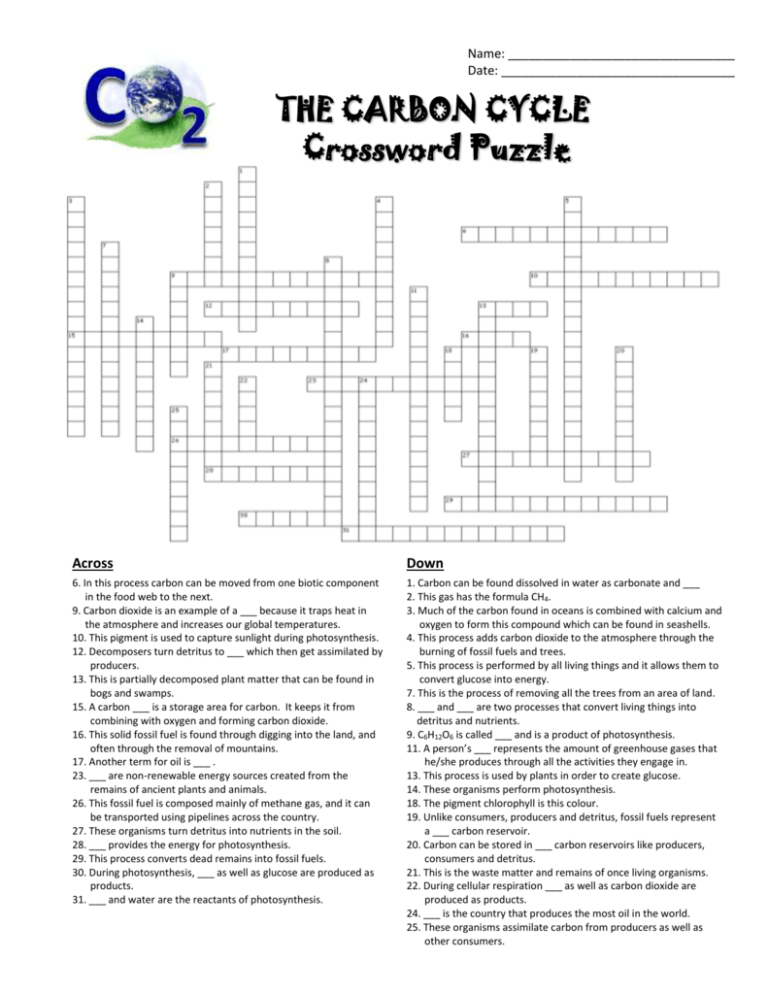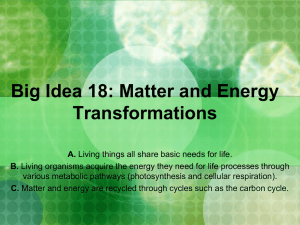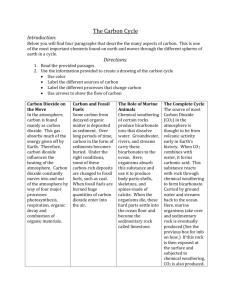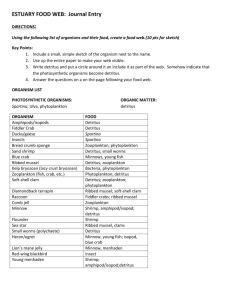
Name: _________________________________
Date: __________________________________
THE CARBON CYCLE
Crossword Puzzle
Across
Down
6. In this process carbon can be moved from one biotic component
in the food web to the next.
9. Carbon dioxide is an example of a ___ because it traps heat in
the atmosphere and increases our global temperatures.
10. This pigment is used to capture sunlight during photosynthesis.
12. Decomposers turn detritus to ___ which then get assimilated by
producers.
13. This is partially decomposed plant matter that can be found in
bogs and swamps.
15. A carbon ___ is a storage area for carbon. It keeps it from
combining with oxygen and forming carbon dioxide.
16. This solid fossil fuel is found through digging into the land, and
often through the removal of mountains.
17. Another term for oil is ___ .
23. ___ are non-renewable energy sources created from the
remains of ancient plants and animals.
26. This fossil fuel is composed mainly of methane gas, and it can
be transported using pipelines across the country.
27. These organisms turn detritus into nutrients in the soil.
28. ___ provides the energy for photosynthesis.
29. This process converts dead remains into fossil fuels.
30. During photosynthesis, ___ as well as glucose are produced as
products.
31. ___ and water are the reactants of photosynthesis.
1. Carbon can be found dissolved in water as carbonate and ___
2. This gas has the formula CH4.
3. Much of the carbon found in oceans is combined with calcium and
oxygen to form this compound which can be found in seashells.
4. This process adds carbon dioxide to the atmosphere through the
burning of fossil fuels and trees.
5. This process is performed by all living things and it allows them to
convert glucose into energy.
7. This is the process of removing all the trees from an area of land.
8. ___ and ___ are two processes that convert living things into
detritus and nutrients.
9. C6H12O6 is called ___ and is a product of photosynthesis.
11. A person’s ___ represents the amount of greenhouse gases that
he/she produces through all the activities they engage in.
13. This process is used by plants in order to create glucose.
14. These organisms perform photosynthesis.
18. The pigment chlorophyll is this colour.
19. Unlike consumers, producers and detritus, fossil fuels represent
a ___ carbon reservoir.
20. Carbon can be stored in ___ carbon reservoirs like producers,
consumers and detritus.
21. This is the waste matter and remains of once living organisms.
22. During cellular respiration ___ as well as carbon dioxide are
produced as products.
24. ___ is the country that produces the most oil in the world.
25. These organisms assimilate carbon from producers as well as
other consumers.
ANSWER KEY: The Carbon Cycle Crossword Puzzle
33 TERMS AND QUESTIONS
consumers These organisms assimilate carbon from producers as well as other consumers.
producers These organisms perform photosynthesis.
decomposers These organisms turn detritus into nutrients in the soil.
detritus This is the waste matter and remains of once living organisms.
nutrients Decomposers turn detritus to ___ which then get assimilated by producers.
photosynthesis This process is used by plants in order to create glucose.
cellularrespiration This process is performed by all living things and it allows them to convert glucose into
energy.
assimilation In this process carbon can be moved from one biotic component in the food web to the next.
deathdecomposition ___ and ___ are two processes that convert living things into detritus and nutrients.
fossilization This process converts dead remains into fossil fuels.
deforestation This is the process of removing all the trees from an area of land.
combustion This process adds carbon dioxide to the atmosphere through the burning of fossil fuels and trees.
fossilfuels ___ are non-renewable energy sources created from the remains of ancient plants and animals.
petroleum Another term for oil is ___ .
peat This is partially decomposed plant matter that can be found in bogs and swamps.
coal This solid fossil fuel is found through digging into the land, and often through the removal of mountains.
naturalgas This fossil fuel is composed mainly of methane gas, and it can be transported using pipelines across
the country.
greenhousegas Carbon dioxide is an example of a ___ because it traps heat in the atmosphere and increases
our global temperatures.
methane This gas has the formula CH4.
carbondioxide ___ and water are the reactants of photosynthesis.
longterm Unlike consumers, producers and detritus, fossil fuels represent a ___ carbon reservoir.
shortterm Carbon can be stored in ___ carbon reservoirs like producers, consumers and detritus.
reservoir A carbon ___ is a storage area for carbon. It keeps it from combining with oxygen and forming
carbon dioxide.
calciumcarbonate Much of the carbon found in oceans is combined with calcium and oxygen to form this
compound which can be found in seashells.
bicarbonate Carbon can be found dissolved in water as carbonate and ___
saudiarabia ___ is the country that produces the most oil in the world.
glucose C6H12O6 is called ___ and is a product of photosynthesis.
oxygen During photosynthesis, ___ as well as glucose are produced as products.
water During cellular respiration ___ as well as carbon dioxide are produced as products.
chlorophyll This pigment is used to capture sunlight during photosynthesis.
green The pigment chlorophyll is this colour.
sunlight ___ provides the energy for photosynthesis.
carbonfootprint A person’s ___ represents the amount of greenhouse gases that he/she produces through all
the activities they engage in.
Created by Anh-Thi Tang – Tangstar Science
Copyright © May 2013 Anh-Thi Tang (a.k.a. Tangstar Science)
All rights reserved by author.
This document is for your personal classroom use only.
This entire document, or any parts within, may not be electronically
distributed or posted to any website.











